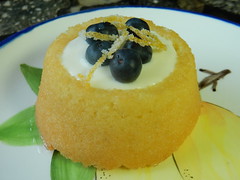 I'm conflicted about this week's Alpha Bakers assignment. One thing is clear: the results are a wonderful cakelet--lovely, light, and lemony. My debate is on the process. Really, nothing about this recipe is difficult, or at least not if you can handle a basic sponge cake. (OK, I'd never baked one before the Heavenly Cakes bake-through, but having completed that sponge cakes are about as easy as the butter cakes I grew up with.) However, it's a typical Rose recipe with many steps and precise timing to get exactly the result Rose was striving for, or so I assume. While I enjoy the results, I wish for a less-involved route to get there.
I'm conflicted about this week's Alpha Bakers assignment. One thing is clear: the results are a wonderful cakelet--lovely, light, and lemony. My debate is on the process. Really, nothing about this recipe is difficult, or at least not if you can handle a basic sponge cake. (OK, I'd never baked one before the Heavenly Cakes bake-through, but having completed that sponge cakes are about as easy as the butter cakes I grew up with.) However, it's a typical Rose recipe with many steps and precise timing to get exactly the result Rose was striving for, or so I assume. While I enjoy the results, I wish for a less-involved route to get there. So: it's a sponge cake made with browned and clarified butter and baked in individual Maryann pans--that's the "shortcake" style now found at American grocery stores that has a depression on the top for berries. (I'll spare you my rant about the real shortcake for berries being a biscuit, not a cake.) Once the cakelets are baked and cooled, they are brushed with a syrup made with lemon juice. Here the lemon type was unspecified, but as I had an abundance of Meyer lemons for the posset, I used Meyer lemon juice in the syrup as well. Give the syrup a few hours to distribute through the cake, then glaze each cake let with an apple jelly glaze. That's the cake part.
So: it's a sponge cake made with browned and clarified butter and baked in individual Maryann pans--that's the "shortcake" style now found at American grocery stores that has a depression on the top for berries. (I'll spare you my rant about the real shortcake for berries being a biscuit, not a cake.) Once the cakelets are baked and cooled, they are brushed with a syrup made with lemon juice. Here the lemon type was unspecified, but as I had an abundance of Meyer lemons for the posset, I used Meyer lemon juice in the syrup as well. Give the syrup a few hours to distribute through the cake, then glaze each cake let with an apple jelly glaze. That's the cake part. The lemon posset is also simple: heavy cream mixed with sweetened Meyer lemon juice and allowed to set. From the recipe I had thought I'd end up with a distinctly layered result, with a thicker top layer, softer middle, and watery bottom. Well, the layers are there but subtle--there's no visual distinction until you start spooning out the posset, and then the texture differences appear. The thicker top layer is spooned onto each cakelet first and allowed to set, preventing the more liquid posset to come from soaking into the cake. Then the less-firm layer is spooned on top and again allowed to set. (The "watery" lowest layer is not used, but makes a great topping for fruit.) Finally, the cakelets are ready to serve. I spooned on a few blueberries for the classic lemon-blueberry flavor combination, and had a very elegant dessert.
The lemon posset is also simple: heavy cream mixed with sweetened Meyer lemon juice and allowed to set. From the recipe I had thought I'd end up with a distinctly layered result, with a thicker top layer, softer middle, and watery bottom. Well, the layers are there but subtle--there's no visual distinction until you start spooning out the posset, and then the texture differences appear. The thicker top layer is spooned onto each cakelet first and allowed to set, preventing the more liquid posset to come from soaking into the cake. Then the less-firm layer is spooned on top and again allowed to set. (The "watery" lowest layer is not used, but makes a great topping for fruit.) Finally, the cakelets are ready to serve. I spooned on a few blueberries for the classic lemon-blueberry flavor combination, and had a very elegant dessert.No doubt it's a wonderful cake, and I wish the process were less involved--maybe the glaze could be skipped if the cake were made and served on the same day, maybe the time frame for putting the posset on the cakes could be compressed, but any way you look at it this recipe will take some time. I imagine I'll repeat it, but will need a special occasion to justify it.









